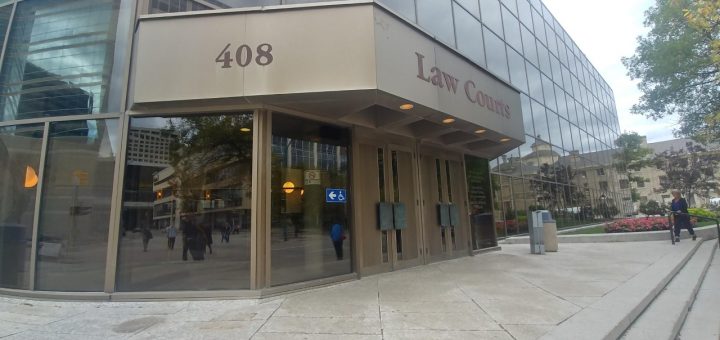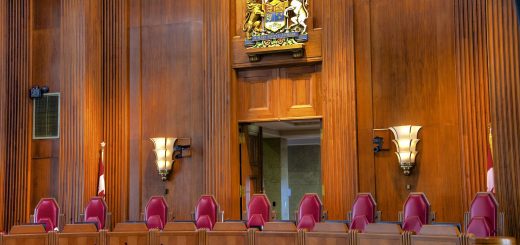Live at the SCC: The SCC Goes to Winnipeg!

For the first time in its history, the Supreme Court of Canada (“SCC” or “the Court”) headed to Winnipeg to hear cases on September 25 and 26, 2019. On Wednesday, the SCC heard arguments in the case R v K.G.K., a criminal case heard as of right on the issue of whether the time judges take in rendering a verdict and giving reasons should be included within the R v Jordan 2016 SCC 27 framework. On Thursday, it heard Conseil Scolaire Francophone de la Colombie-Britannique v British Columbia (“Conseil Scolaire Francophone de la Colombe-Britannique”), a case dealing with minority language rights and the extent to which British Columbia must provide French language schooling across the province.
In addition to hearing these two appeals, members of the Court also engaged in a number of public outreach activities. On their first day in Winnipeg, the Justices of the SCC met with local high school students and took their questions. After the hearings of R v K.G.K., all nine justices participated in a meet and greet event at the Canadian Museum of Human Rights. In between the morning and afternoon sessions of hearing Conseil Scolaire Francophone de la Colombie-Britannique, members of the SCC as well as other Manitoba justices participated in a ceremony where they were gifted Sacred Eagle Feathers from Indigenous members of the community. On their final day in Winnipeg, the Court met with a number of different communities, including the Francophone community, the Indigenous community, and the Metis community.
Overall, the trip appeared to run smoothly and there was a great deal of public interest in the fact that the SCC was in Winnipeg hearing cases for the first time. Although this trip was a standalone trip and not a commitment to have the Court travel the country to hear cases, it was a positive experience and something that members of the Court appear interested in doing again.
The Hearings
R v K.G.K
R v K.G.K. is an appeal from the Manitoba Court of Appeal on whether the time judges take to deliberate should be included in the presumptive ceilings on trial delay set out in Jordan. K.G.K. was charged with sexual interference and invitation to sexual touching. Throughout the proceedings at the trial level there were extensive delays, taking 42 months between the time when K.G.K was charged and when he received a guilty verdict. Included in that time is the nine months that the trial judge took to decide the case. In Jordan, the SCC set presumptive ceilings at 30 months, otherwise the charges ought to be stayed as a result of a violation of s. 11(b) of the Charter.
At the Manitoba Court of Appeal, the majority found that the decision-making time should count in the total time for the purposes of Jordan. Because there was a dissent at the Court of Appeal, the case was heard at the SCC as of right.
During the hearings, the justices of the SCC all seemed to be in agreement that K.G.K.’s case was delayed. Where there seemed to be disagreement was whether this case was an appropriate case for awarding a broader remedy dealing with delays caused by trail judges. For starters, the record was lacking, and there are hurdles in getting evidence from judges about the time it takes for them to deliver their verdicts. It was argued by the Attorney General that including the time judges take on their reasons could threaten judicial independence and put pressure on judges working in a criminal law system that is already strapped for resources.
There were four interveners: the Director of Criminal and Penal Prosecution, the Director of Public Prosecutions, the Attorney General of Ontario, and the Criminal Lawyers’ Association. Most of the interveners expressed concern that strict guidelines on judges could threaten judicial independence and the administration of justice if judges are not free to write reasons with enough time. The Director of Public Prosecutions also raised concern that the only remedy available in the case of an 11(b) Charter violation is a stay of proceedings – a remedy reserved for the most serious breaches. The Attorney General of Ontario highlighted that there are guidelines in Ontario which dictate the timeframes judges should be aiming for when deciding criminal cases. Finally, the Criminal Lawyers’ Association intervened to argue that the entire time frame between the time someone is charged with an offence to the time they receive a verdict should be subject to the presumptive ceilings in Jordan. For people accused of a crime, the stigma of being charged with a criminal offence and any accompanying restrictions on their liberty remain in place until a verdict is delivered and so the ceilings should apply throughout.
Conseil Solaire Francophone de la Colombie-Britannique v British Columbia
This case deals with minority language rights guaranteed under s. 23 of the Charter. S. 23 gives parents the right to send their children to school in either official language, provided that there are enough children in the area requiring minority language schooling to justify the costs to the government of providing the schooling.
The Conseil is challenging British Columbia’s practices regarding funding French-language primary education, arguing that there needs to be more funding to help maintain school properties. The province argued that doing so would cost too much and that there are not enough francophone students to create an obligation under s. 23 of the Charter. At trial, the judge said that the province breached parents’ s. 23 rights in not providing enough funding for minority language education, though they were not required to provide all of the buildings and infrastructure originally asked for. The trial judge also awarded $6 million in damages because of the breach.
At the British Columbia Court of Appeal, the Court emphasized that s. 23 required considerations of practicality and that damages were inappropriate. The policies in British Columbia were not unconstitutional at the time, and were only found unconstitutional later by the trial judge. There is no liability for policies that are later determined to be unconstitutional.
Because of the wide array of issues at appeal – the content of the s. 23 right, the extent to which practicality should factor into the s. 23 analysis, the role of s. 1 in the analysis, and whether damages can be awarded for policies that are later determined to be unconstitutional – there were many interveners on the case. Because of the wide range of issues raised in the case, the SCC granted leave to 18 different interveners, who presented arguments on both sides of the issue, focusing mostly on whether the government can justify breaches of s. 23 based on economic hardship (and just what the limits of economic hardship are) and whether costs are available for policies that breach Charter rights before courts have ruled that the policy breaches Charter rights.
Public Engagement
Throughout their trip to Winnipeg, the SCC – and especially Wagner CJ – emphasized the importance of public engagement and reconciliation with Indigenous communities. At the Canadian Museum for Human Rights, all of the justices presented information about the Supreme Court works, including how cases are heard at the Supreme Court. They also took questions from the audience and spent some time speaking to members of the public after the event. Some of the questions posed gave the justices an opportunity to explain some of the efforts the SCC is making to become more accessible to the public – including the support provided to self-represented litigants and the commitment to clear language case briefs to accompany all of the decisions published by the Court.
There also were a number of opportunities for the members of the SCC to highlight the important role of the judiciary in both the need for reconciliation and the implementation of the recommendations of the Truth and Reconciliation Commission. Members of the SCC and the Manitoba bench were gifted Sacred Eagle Feathers and committed to carrying out reconciliation in their work.
Throughout the trip, there was a fairly high level of engagement with the events. At the hearings, there were plenty of people there to see the SCC live, and there was a system of moving spectators in an out of the courtroom to ensure that everyone who came would be able to see the court live at some point and could view the hearings live in an overflow room. Moving people in an out of the hearings seemed to work well and was minimally disruptive to the proceedings. At the public events, there were many members of the public attended, though during the questions from the audience to the SCC, there was a concern expressed about the lack of youth engagement – to which Wagner CJ answered that there were planned visits to high schools and to university campuses to reach these groups.
Conclusions
For the first hearings outside of Ottawa, the hearings and public events ran exceptionally smoothly and the court staff clearly was well-rehearsed and well-prepared to conduct hearings outside of the Supreme Court in Ottawa. Having the opportunity for the SCC to host hearings in different locations could better enable cases where parties may incur significant travel costs to participate in hearings in Ottawa could better enable access to justice. Moving hearings around could also enable communities directly affected by decisions to witness the hearings in person.
Trips like this also give members of the public the opportunity to engage with the highest court who might not otherwise be able to – and if the numbers of people who showed up to the hearings and events indicates, there are a great number of people who are interested in doing so.
Provided these trips are not cost-prohibitive, it seems like an effective way for Canadians to engage with our highest court, and the openness and transparency involved in making live hearings even more accessible for Canadians can have a very positive impact on the administration of justice. Though this experience of bringing SCC hearings outside of Ottawa was more of a pilot project – the reception was positive and there were a number of indications that Wagner CJ was interested in continuing to develop a closer relationship between Canadians and the justices of the SCC.







Join the conversation